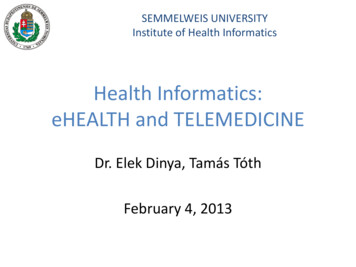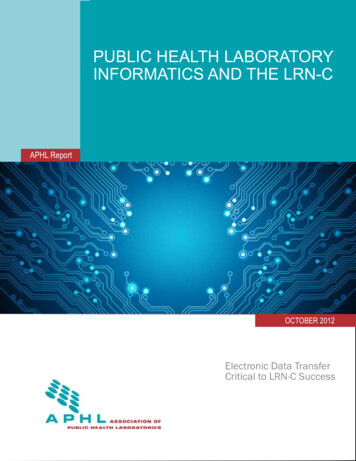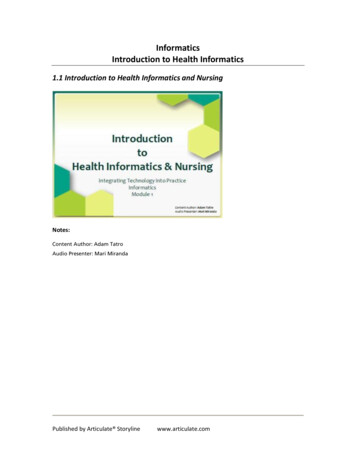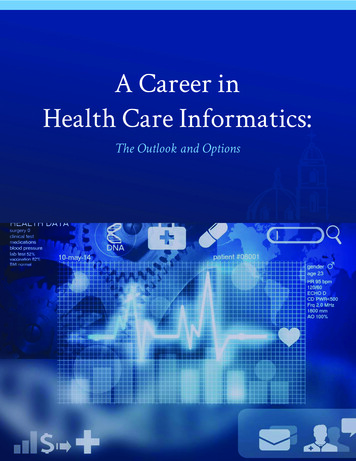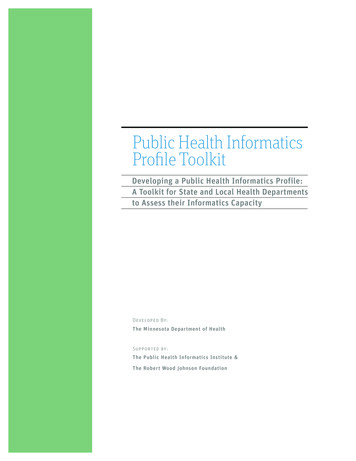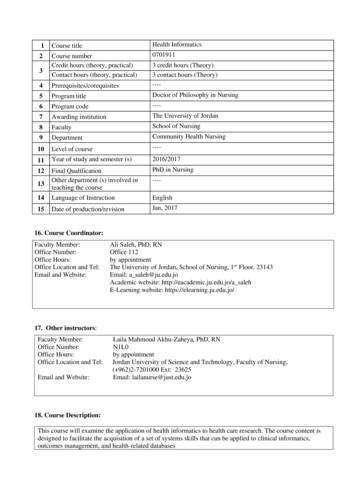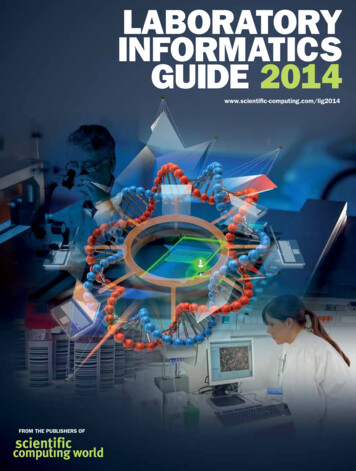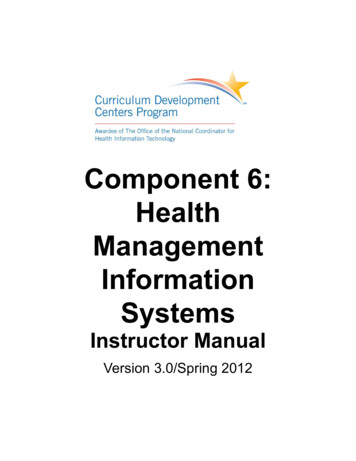
Transcription
LaboratoryInformaticsGuide 2021Understanding the needs of the laboratoryFrom the publishers .com/lig21
TransformDigital Lab Consulting provides independent strategicconsulting to enable organisations of all sizes to transform theirbusiness through better use of informatics.We provide clear, actionable advice to helpcompanies find the most effective solutionfor their environment.We have over 20 years of experience acrossthe entire value chain, from early research tomanufacturing.We are based in the UK and work globallywith our clients and partners.Discover more atdlc.io 44 (0)1543 547607info@dlc.io
LABWARELIMS and ELN in a single platformAutomation software for all laboratoriesOffices worldwide supporting customersin more than 125 countrieswww.labware.com
ContentsISoftware tools help combat4 Covid-19Robert Roe looks at how Covid-19 is drivingchanges in the laboratory10 Vendor predictionsHow laboratory technology and software couldchange due to increased pressures to workremotely caused by the pandemic22 Digitial transformationSophia Ktori looks at the role software plays intransforming the laboratory28 Looking at cancerAdvances in computer vision combined with AIcomputing help pathologists to more accuratelyidentify subtypes of cancerMaking science opencollaboration30 Empoweringwith the cloudThe European Bioinformatics Institute isdeveloping tools and infrastructure to promoteopen science and provide programmatic access tobiological dataCloud technologies can simplify data sharingand collaboration, writes Thermo Fisher’s DarrenBarrington-Light16genomics20 LeadingresearchThe Wellcome Sanger Institute’s Julia Wilsondiscusses the role of the research centre and itsimpact on the wider scientific communitySUBSCRIPTIONS: The LaboratoryInformatics Guide 2021 is publishedby Europa Science Ltd, which alsopublishes Scientific Computing World.Free registration is available to qualifyingindividuals (register online atwww.scientific-computing.com).Subscriptions 100 a year for six issues toreaders outside registration requirements.Single issue 20. Orders to ESL, SCWCirculation, 4 Signet Court, CambridgeCB5 8LA, UK.Tel: 44 (0)1223 221030.Fax: 44 (0)1223 213385. 2020 Europa Science Ltd.Whilst every care has been taken in the compilation of this magazine,errors or omissions are not the responsibility of the publishers or ofthe editorial staff. Opinions expressed are not necessarily those ofthe publishers or editorial staff. All rights reserved. Unless specificallystated, goods or services mentioned are not formally endorsed byEuropa Science Ltd, which does not guarantee or endorse or acceptany liability for any goods and/or services featured in this publication.US copies: Scientific Computing World (ISSN 1356-7853/USPS No018-753) is published bi-monthly for 100 per year by Europa ScienceLtd, and distributed in the USA by DSW, 75 Aberdeen Rd, Emigsville PA17318-0437. Periodicals postage paid at Emigsville PA. Postmaster:Send address corrections to Scientific Computing World PO Box 437,Emigsville, PA 17318-0437.Cover image and all other images: 32 Supplier’s directoryOur guide to find where to turn to for thesuppliers you needEDITORIAL AND ADMINISTRATIVE TEAMManaging Editor: Tim Gillett(editor.scw@europascience.com)Editor: Robert Roe(robert.roe@europascience.com)Feature Writer: Sophia KtoriCirculation/readership enquiries:subs@europascience.comADVERTISING TEAMAdvertising Sales Manager: Mike Nelson(mike.nelson@europascience.com)Tel: 44 (0) 1223 221039 Fax 44 (0) 1223 213385DESIGN TEAMProduction manager: David Houghton(david.houghton@europascience.com)Senior graphic designer: Zöe Andrews(zoe.andrews@europascience.com)t is clear that Covid-19 has had asignificant impact on laboratoryoperations. Even for laboratories thatare not working directly on Covid-19testing, drug and vaccine development,restrictions on laboratory space and accessto equipment are putting a significantburden on scientists.Thankfully, laboratory informaticssoftware tools can shoulder some of thatburden by providing a platform for remoteaccess, automation of laboratory operationsor by providing access to data and tools forcollaboration to keep scientists workingproductively.This issue of the Laboratory InformaticsGuide aims to highlight the workingpractices of researchers, and highlighttechnologies and tools that can helpovercome the challenges that scientistsface in the laboratory. We start with an indepth look at the work that has been goingon around the world to fight against thepandemic on page 4.We’ve a series of vendor predictions forthe year ahead beginning on page 10. Thiefeatures experts from several informaticssoftware providers discussing the role ofautomation, cloud-based systems, remoteaccess tools, and other technologies thatcan ensure laboratory productivity, despitereduced access for many users.Starting on pages 16 and 20 are twointerviews with research leaders. The firstfeatures the European BioinformaticsInstitute and the second takes a look at theWellcome Sanger Institute. The interviewsshare some of the work that has beenconducted on Covid-19 and the importanceof open science in fighting the pandemic.Digital transformation in the laboratoryis the focus on page 22, as Sophia Ktori talksto informatics software providers about thetechnologies and tools scientists can use toadvance lab operations.On page 28 we consider how advancesin computer vision, combined with AIcomputing, are helping pathologists moreaccurately identify subtypes of cancer. Andfinally, Thermo Fisher’s Darren BarringtonLight details the importance of cloud-basedsolutions on page 30.CORPORATE TEAMManaging director: Warren ClarkWeb: www.scientific-computing.com3
LABORATORY INFORMATICS GUIDE 2021Covid-19 changesthe laboratorylandscapeDemand for testing and requirements for remote workingtools drive changes in the laboratoryThe pandemic has defined thedevelopment of laboratorysoftware and technologies,as collaboration and remote workingtools become requirements to aproductive laboratory.It has increased demand forlaboratory services in areas such astesting, genomics studies and vaccineand drug development. Howeverthese demands must be met withrestrictions on laboratory space andmore demanding project timelines.To facilitate this research andscale-up testing capabilities,laboratory scientists are using4laboratory information managementsystem (LIMS) and electronic laboratorynotebook (ELN) software to helpmanage collaborative work, andpromote reduced-capacity workingenvironments in the laboratory.Patrick Rose, digital science productmanager at Thermo Fisher Scientific,notes that there has been a pivot inthe tools used in laboratories due toCovid-19. ‘The labs are starting workleaner, they are having to collaboratewith other partners, other contractresearch organisations [CROs] tohelp battle the pandemic and find thevaccine.“The tooling andsolutions, likethe LIMS that weoffer, becomemore pivotal andcritical”‘What we are seeing is an increasedneed to work remotely due toalternating days, slimmer shifts tryingto minimise the time people are in theretogether. But, they still need to workon their results, gather and share dataand collaborate,’ added Rose. ‘So thewww.scientific-computing.com/lig21
LABORATORY INFORMATICS GUIDE 2021tooling and solutions, like the LIMSthat we offer, become more pivotaland critical. It is being able to see whatother users have done – potentiallywhat they may have done in the lastshift, what you need to do for the nextshift.’Tools facilitate remote workingLIMS or ELN systems can help tominimise the time scientists haveto spend in the lab, as mobile alertsor other features can help notifyscientists when their experiments willbe finishing. Streamlining data sharingand access also helps facilitate agiledecision making, and lets scientistsaccess data and analyse or work ondata from home.Several LIMS and ELN vendors arenow equipping their software with preconfigured workloads to help scientistsget set up with key laboratoryoperations. This reduces the amountof setup and administrative work thatneeds to be done by scientists, whichshould lead to increased productivity.Lauren Taylor, digital sciencesolutions manager at Thermo FisherScientific, said: ‘Some of thoseworkflows we have already preconfigured to get customers up andrunning as quickly as possible. In termsof the integration of instrumentation,for example, you may have specimensin the lab that you want to sequence,that information needs to be put ontothe sequencer so that you know whichsamples you are sequencing, and thatinformation can be relayed back to thecorrect sample.‘The integration really is automatingthe push of information to thesequencers, so that you are notcopying and pasting or uploading anddownloading files manually.’Using AI in the fight against Covid-19AI tools are becoming increasinglyuseful to laboratory scientists. Apartnership announced betweenElsevier and ExactCure provides asoftware platform collaboration todevelop and offer to hospitals – withoutcharge – drug-specific exposuremodels for 20 already approvedmedicines that are being tested aspotential treatments for Covid-19.Each drug-specific model,generated using ExactCure’s AI-drivensimulation platform, will help to predicta drug molecule’s pharmacokineticproperties in each individualwww.scientific-computing.com/lig21“We put automated softwareprocesses in place to help capturetesting data: that may be challengingbecause you are out in the fieldsomewhere”patient, according to their age, sex,whether they have other diseases –comorbidities – and other factors, andthereby give guidance to clinicians onlikely optimum dosing.Development of the drug exposuremodels will leverage data held inthousands of drug-related documentsin Elsevier’s PharmaPendium drug dataresource, which contains decades ofsearchable FDA and EMA regulatoryapproval and related documents on thedrugs.Olivier Barberan, director oftranslational medical solutions atElsevier explains: ‘We will provideExactCure with information held inPharmaPendium that spans morethan 50 drug-specific parameters,including PK and pharmacodynamicdata, safety data, adverse events anddrug-drug interaction records, togetherwith data on drug efficacy. This mayencompass many thousands of reports,for example, there were in excess of13,000 records just for the antiviraldrug ritonavir, which is one of the drugsunder consideration for Covid-19therapy.’ExactCure is exploiting thePharmaPendium data and its own AItools to build a simulation-based digitalcompanion – a digital twin applicationfor smartphones that patients woulduse to help make sure that they usemedicines safely, and at an appropriatedose and frequency, ‘whether thatbe an OTC painkiller, or an antiviralmedicine,’ Fabien Astic, ExactCureco-founder, said. ‘This can help toprevent underdosing, overdosing,and to prevent drug-drug interactionsor adverse events relating to theindividual’s health status, or evengenetic profile.‘The AI-based software derives thepersonalised guidance according to keypatient-specific characteristics suchas weight, age, gender, renal and liverfunction, smoking status and geneticbackground. Importantly, it could alsofeedback information to the prescribingphysician, so that they will know howwell the patient is sticking to their drugschedule,’ Astic suggested.‘Our first model, for paracetamol,could help dramatically reduceoveruse of the drug and even preventoverdose-related deaths.’ ‘We signeda partnership with Vidal, a key playerof medical information in France, tointegrate our technology into theirVidal Sentinel platform designedfor hospitals. They call our API[Application Programming Interface]and the pharmacist or doctor can runpersonalised simulations until theyreach what they estimate to be the bestposology for a given patient,’ addedAstic.Digital companion apps could alsobe utilised by the pharma industryto support clinical drug trials andpotentially speed time to market, whilereducing attrition at the trials stage.Dosing optimisation for Covid-19Certara launched the Covid-19Pharmacology Resource Center in April,an online resource giving scientistsaround the world access to simulationand modelling tools to aid the designof clinical trials and optimise dosingregimes for candidate drugs such ashydroxychloroquine, and lopinavir/ritonavir, against Sars-CoV-2. Funded bythe Bill and Melinda Gates Foundation,and supporting global collaboration inthe drive to develop new treatments forCovid-19, the centre offers researchersa workbench of in-silico modelling tools,integrated with existing and emergingdata.The centre offers an accessibleoutreach of the expertise that Certaraprovides in the global Covid-19Therapeutics Accelerator, which hasbeen set up with an initial 125m infunding from the Gates Foundation,Wellcome and Mastercard, through5
LABORATORY INFORMATICS GUIDE 2021“Manual data entry can lead toserious errors, meaning thatsamples cannot be tested or that thespecimens cannot be traced back tothe correct source”which the World Health Organization,governments, healthcare providersand industry are collaborating to speedthe development of therapeutics totreat Covid-19 or prevent Sars-CoV-2infection.Craig Rayner, president, integrateddrug development at Certara explains:‘Certara is providing expertise intranslational and clinical pharmacology,quantitative science and regulatorystrategy to support critical stagedecisions, clinical trials design anddosing optimisation for Covid-19.‘For a virus like Sars-CoV-2, forexample, Certara researchers investsignificant efforts in bringing thebiology and math together to helpimprove decision making for newtherapeutics. One can now evaluate howthe virus enters cells, how it interactsand replicates, what the immune systemis doing in response, via sophisticatedquantitative pharmacology frameworksand predictive tools and then simulatenew situations,’ he suggested.‘We can take huge amounts ofdata from preclinical models, in vitrotesting and clinical experience, as afundamental foundation on which touse math engines to model what willhappen in different trial scenarios, startto simulate clinical trials accurately, andthen add data derived from new trialsback into the model, and validate insilico learning,’ said Rayner.Certara’s Simcyp Simulator has beendeveloped as a suite of modules that6simulate drug pharmacokinetics (PK)that can predict and describe how thebody affects the drug-drug absorption,distribution, metabolism and excretion(ADME), and how PK may be altered byformulation, patient variables such asage, gender or genotypic information,or concomitantly administeredmedications.The Simcyp Simulator linkslaboratory data to in vivo ADME dataand when integrated with and extendedto pharmacodynamic (PD) information(how the drug effects the body) suchas biomarkers or clinical efficacy andsafety, is a powerful tool to supportdosing decision-making in new trials.Keith Nieforth, senior directorof Certara’s software division, said:‘Designing and running clinical trials forany drug or vaccine is hugely expensiveand time consuming, so there is a greatneed to boost efficiency, and improvethe likelihood of success.‘The Certara tools can also modeldrug activity at particular sites ofaction, and look at the physicochemicalproperties of that molecule in thecontext of other molecules withsimilar structure and activity, to makepredictions on whether the drug willreach target tissues, such as the lung, ifwe consider Sars-CoV-2,’ Nieforth said.‘In the case of Covid-19drug development, the Certaramodels integrate simulationsof drug pharmacokinetics andpharmacodynamics, alongside virusinteraction with the host and symptoms.‘You can then link those modelstogether and that enables you tosimulate what you think might happenin clinical trials. Ultimately, modellingand simulation can reduce the numberof patients, or trial arms required, aswell as evaluate the influence of otherdesign factors on trial outcomes, andso improve the probability of success,’added Nieforth.Advancing viral testingWith the world’s focus on the pandemic,LIMS providers are working to developsolutions tailored to assist in the testingand management of virus samples.By streamlining processes, increasingconnectivity and reducing manual dataentry samples can be tested moreefficiently and more accurately.Edward Krasovec, director of clinicalsolutions at LabWare explains: ‘Manualdata entry can lead to serious errors,meaning that samples cannot be testedor that the specimens cannot be tracedback to the correct source. Whendealing with healthcare, this meanspotentially very sick patients missingout on results from their tests.’John Gabathuler, director ofindustrial and environmental atLabWare, also highlighted theimportance of removing errors frommanual data entry processes. ‘They areprocesses that have not been therepreviously. They have had to set theseprocesses up, and therefore they arewww.scientific-computing.com/lig21
Dive IntoYour DataBSSN SciDiver lets you access andanalyze your laboratory data withanyone, anywhere, on any device.Scientific breakthroughs aren’t confined to the bench.Collaborate with remote colleagues and connect yourinstruments with SciDiver, a secure cloud solutionfor organizing, harmonizing, and visualizing all youranalytical and biological data.Learn more at bssn-software.comThe life science business of Merck KGaA, Darmstadt, Germanyoperates as MilliporeSigma in the U.S. and Canada. 2020 Merck KGaA, Darmstadt, Germany and/or its affiliates. All Rights Reserved. MilliporeSigma, the vibrant M and BSSN Software aretrademarks of Merck KGaA, Darmstadt, Germany or its affiliates. All other trademarks are the property of their respective owners. Detailedinformation on trademarks is available via publicly accessible resources. 34066 11/2020
LABORATORY INFORMATICS GUIDE 2021going through them for the first time,or they are not as tried and tested, sothe chances of systems not gettingthe right information can exacerbateproblems. With the current situation youwant to be as accurate as you possiblycan, as fast as you possibly can,because people’s lives depend on it.‘We are trying to help by puttingautomated software processes in placeto help capture the testing data: thatmay be challenging because you are outin the field,’ added Gabathuler.Labware developed the PortableDisease Surveillance Lab kit inpartnership with Tangen Biosciences.They recently announced a partnershipfor LabWare to distribute Tangen’sGeneSpark device as part of the kit inresponse to the pandemic.The kit connects to the LabWareLIMS software portal to capture patientdemographic and clinical information,document field collection of respiratoryswabs for Covid-19 testing, attainingthe sample, and rapidly disseminate thisdata to public health agencies.Beyond Covid-19, Tangen is makinga Flu/Covid-19 Panel that can detect FluA, Flu B and Covid-19 simultaneouslyfrom one patient sample in a singleprocessing run, so that patients with flulike symptoms will know whether theyhave flu or Covid-19, or neither.Richard Birkmeyer, president andCEO at Tangen, said: ‘The pandemic istragic for many families. Everyone atTangen Biosciences has been workinglong hours to have our sensitiveCovid-19 assay on the market. Moreimportantly, we believe the combinedCovid-19 and Flu A/B test will be acritical surveillance tool for respiratory8illness management. In addition to theCovid-19 test, we are also developinga sepsis panel and an antimicrobialresistant panel, and are currentlylooking for strategic partners for both.’The firms are aiming to continuethis partnership to include multi-targettesting. The combination of Tangen’srapid, highly sensitive and point-of-caremolecular diagnostics and LabWare’sreal-time data reporting LIMS softwareshould enable public health systemsto react quickly in terms of quarantineguidelines, patient tracing, hotspotmonitoring and infection surveillance.Maintaining interoperabilityCovid-19 demands that laboratoriesadopt new practices and workflowsquickly, but when new technologiesare created and deployed quicklyinteroperability can become achallenge. As Labware’s Krasovecpoints out, the company’s strategyhas been to recognise that no singleorganisation can do it all – collaborationwith the right partners is crucial.With data analytics and AIapplications becoming increasinglywidespread, new data sources and waysof analysing data are now available. AIand data analytics also asks questionsof existing data. Has legacy data beenstored in a way that allows it to be easilyreused in the future? If that is not thecase, then an organisation must cleanand order that data before integrating AIinto their workflows.Interoperability between softwaresystems, different workflows and thevarious outputs that these processescreate, are key to providing a stableplatform for laboratory data.As LIMS providers collect andstore data for laboratories, it iscrucial they play a role in working withspecialised software partners to ensureinteroperability. ‘It’s not just abouthaving an instrument that can do thetest. That is just one part of the process.If you cannot get that test where itneeds to go, to the healthcare provider,patient, or public health authorities, thenit is a wasted effort,’ noted Krasovec.‘Not to mention that the people you aretesting are out there, potentially notknowing they are infected, and theycontinue to infect others.Gabathuler added: ‘That is why wehave this enterprise laboratory platform,because there are a lot of parts to it andthey can all act up in a nice cohesivejoined-up way to help in lots of differentareas. You have got a functionalplatform and then everything can beleveraged from that going forward.’Rapid adoption of new technologiesrequires LIMS providers to be agile inensuring interoperability with softwarepartners. This enables them to providethe infrastructure or platform that cannot only interact with instruments andlaboratory equipment, but also dataanalytics or AI software frameworks.‘There is a rapid adoption ofnew technologies in the healthcarelaboratory in terms of a genetic-basedtesting platform which has spawnedthis order of magnitude difference inthe amount of data that is created – thatdata has to be managed,’ said Krasovec.‘Quite often it involves specialisedtechnologies to interpret that data.’‘As a LIMS provider, we are not adomain expert in analysing geneticdata. It is important we are able toget data that may be captured froman instrument and interact withthe software specialised to do thatinterpretation of these gigabytes of datathat can be generated by sequencingprocesses,’ Krasovec added. ‘That isobviously very important, because noone system is the be all and end all,and they need to coexist and shareinformation with other systems.‘We manage the workflow processand there may be data analytics thatgoes along with it that could be doneby specialised software. Then we areresponsible for distributing the finalreport to whoever it needs to go to. Wehave a role in the process. It is importantthat we are able to interact with theother systems as well,’ said Krasovec. nwww.scientific-computing.com/lig21
More time for:exceeding expectations.Connect your QA/QC workflows to increaseproductivity & stay ahead of scheduleQA/QC laboratories are all about processes. Processes to managethe lab, processes to manage the data, processes to manage theprocesses. Thermo Scientific SampleManager LIMS, LES andSDMS software brings it all together and delivers more for yourorganization, streamlining workflows, easing compliance andenabling scientists to focus on delivering high quality results, faster.Find out more at thermofisher.com/samplemanagerFor Research Use Only. Not for use in diagnostic procedures. 2019 Thermo Fisher Scientific Inc. All rights reserved.All trademarks are the property of Thermo Fisher Scientific and its subsidiaries unless otherwise specified. AD80148-EN0219
LABORATORY INFORMATICS GUIDE 2021LaboratorytechnologychangesInformatics experts share their views on thefuture of the laboratory and how things mightchange due to the added pressure of Covid-19What do you think will be the biggestchange in the laboratory?Richard Milne VP and generalmanager of digital science atThermo Fisher:One of the things that 2020 has doneis it has created a tipping point in thelaboratory. People will find they needto reconfigure lab space and theconfigurations of labs. But we are alsoseeing higher demand to make the labavailable.How can people work from outsidethe facility? How can people accessdata when they are not inside thelaboratory? How can they collaboratewhen they cannot travel as easily asthey did? How can they control theirexperiments and run their lab withoutbeing inside it?A lot of those drivers that we areseeing in all aspects of society atthe moment are going to continue topersevere. We are finding that there isa very significant increase in peoplewanting to see technology shouldersome of the burden and assist inthe changing parameters of theworkspace. We are seeing it in everyindustry and every walk of life, but itis also being clearly illustrated in thelaboratory.We are doing a lot of work aroundcloud-based computing platforms,collaboration environments, datamoment and data storage. There is10a lot of work going on at the momentaround connected instruments andhow data can flow more easily.Stephen Hayward, Biovia technicalmarketing manager:Transformation of the user experiencewith the inclusion of advancedtechniques. For example, voicerecognition, where a use case wouldbe dictating observations and resultsutilising scientific awareness in therecording process.Transfer to cloud-based systems,driven by corporate IT policy changes– this enables more remote access,which is becoming critical in times of apandemicAI – truly leveraging all existingknowledge from the lab to betterguide future work. Finally, augmentedreality technology which can transformlab process execution – visualisingadditional contextual information, oralerts about sample status and pendingtasks.Many lab technicians are considered‘essential workers’, so they havecontinued working during a pandemic.But the way of working has changed.Teams working in the lab are now splitinto smaller groups that are workingin shifts to minimise contact whilecovering the workload. This makesefficient and flexible laboratoryscheduling critical.www.scientific-computing.com/lig21
LABORATORY INFORMATICS GUIDE 2021“We are doing a lot of work aroundcloud-based computing platforms,collaboration environments, datamoment and data storage”Additionally, all tasks that are notrelated to physical activities in the labare now performed remotely. Therefore,it is important to be able to work withexperimental data away from the labwhile retaining contextual data fordecision making, which is typicallysupported by cloud solutions.How has Covid-19 changed how thescientific ecosystem works together?Arvind Kothandaraman, generalmanager diagnostics, PerkinElmer:A major takeaway from Covid-19 hasbeen that every second matters whenit comes to a response. In order to bemore nimble and agile, labs requiretools with high levels of sensitivity andreliability in order to detect disease,develop therapeutics and discoverpreventive measures that can betaken before there is an opportunityfor a surge to begin. Early detectionand diagnostics are vital for labs, asscreening becomes the new normal.We will also see a shift towardsmolecular testing and surveillancein general over the next year or two.Covid-19 necessitated this shift, andlabs have realised that they mustbe equipped with life science anddiagnostic tools to better managethe spread of infectious diseasesnow and in the future. While we hopeto never experience a pandemic ofthis magnitude again, it is in our bestinterest for labs to proactively conductsurveillance to better manage thepotential risk.Collaboration among scientists isthe backbone of labs. The fight againstCovid-19 has been prioritised acrossthe globe, and this has accelerated howall organisations work in a united effortto ultimately serve the public. In thatsense, pharmaceutical and biotech,which are conventionally consideredcompetitors, have joined together towork towards the same goal.Information sharing will helpwww.scientific-computing.com/lig2111
LABORATORY INFORMATICS GUIDE 2021ensure the abundance of testing kitsand therapeutics for everyone andeverywhere. The collaboration hasbeen unprecedented, and we’ll seethis approach continue in many waysmoving forward.Dr Barry Bunin, CEO of CollaborativeDrug Discovery (CDD):While the concept of remote workingis nothing new, the Covid-19 pandemichas created a new reality where manyscientists are forced to spend lesstime in the lab and instead work fromalternate locations. One of the mainchallenges that comes with this is dataavailability – do you have access toyour data outside of the lab? How doyou share data with colleagues andcollaborate when everyone is physicallyseparated? And if you do share yourdata, how do you make sure there isadequate access control to preventunauthorised access? These areimportant considerations, in particularin deadline-driven projects whereachieving specific research milestonesis critical for the success of theorganisation.At CDD, we have been enablingscientific collaborations for the last 16years through our CDD Vault-hostedinformatics platform. Anyone withaccess privilege for a project canmanage and analyse data from any webbrowser anywhere in the world, and thewhole team can work together in realtime, even when separated by physical12distance. The value that our solutionbrings has never been greater intoday’s world of virtual companies anddistributed research teams.In fact, we have
Thankfully, laboratory informatics software tools can shoulder some of that burden by providing a platform for remote access, automation of laboratory operations or by providing access to data and tools for collaboration to keep scientists working productively. This issue of the Laboratory Informatics Guide aims to highlight the working
